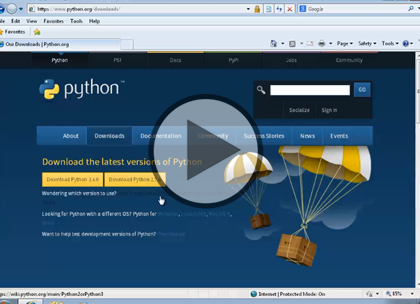Course description
In this course we are going to take a look at the fundamentals of Python 3. We are going to start off by seeing how we download and install it. Then we'll see how we can use python both interactively at the command line as well as in a source code editor. Then we will go into the language itself and will take a look at some of the simple concepts behind the syntax. We will talk about comments and variables and we'll talk about the importance of indenting code which is a crucial aspect of python syntax. Then we'll go over the keywords of the language and the built-in types. And we'll also talk about documentation strings which are specially marked strings that become attached to objects within our code.
Prerequisites
This course teaches anyone who is interested in learning the basics of programming computers using Python 3. This course has no programming language pre-requisites and only assumes the basic familiarity with computer usage that virtually everybody has. Anyone with moderate computer end-user experience should be able to take this course.
Learning Paths
This course is part of the following LearnNowOnline SuccessPaths™:
Python Development
Meet the expert
Peter Thorsteinson has been working for two decades in many areas of Microsoft-based software development technologies, including all the latest languages, frameworks, and tools. He has been involved in several large scale software development projects and has authored and co-authored several books and courses relating to ASP.NET, AJAX, JavaScript, WPF, WCF, WF, ADO.NET, and LINQ. Peter is currently focusing on ASP.NET MVC, jQuery, Task Parallel Library, Windows Azure, and SharePoint Development.
Course outline
Install and Configure
Installing Python (16:40)
- Introduction (01:10)
- Python Fundamentals (00:05)
- Getting Started (00:36)
- Demo: Python - Versions (05:01)
- Demo: Python - Download (04:33)
- Demo: Python - GUI (05:04)
- Summary (00:08)
Python Documentation (30:24)
- Introduction (00:19)
- Characteristics (02:59)
- Features (06:05)
- History (01:27)
- Documentation and Resources (01:18)
- Demo: Python Documentation (05:04)
- Demo: Documentation - strings (03:36)
- Demo: Documentation - lists (04:09)
- Demo: Documentation - lang.ref (05:07)
- Summary (00:15)
Command Line (17:29)
- Introduction (00:50)
- Python 2 vs Python 3 (00:41)
- Editors and IDEs (02:05)
- Web Frameworks (01:17)
- Cloud (00:45)
- Big Data, ML, and Science (01:34)
- Running Code from Command Line (00:19)
- Demo: Command Line (05:05)
- Demo: Command Line (Cont.) (04:32)
- Summary (00:15)
Variables (28:35)
- Introduction (00:20)
- Python Shell (01:49)
- Syntax Documentation (00:35)
- Comments (01:19)
- Literal Strings (04:05)
- Variables (00:56)
- Demo: Variables - Intro (04:37)
- Demo: Variables - Unicode (04:11)
- Demo: Variables – Run (02:40)
- Demo: Variables - Delete (02:41)
- Demo: Variables – Print (04:53)
- Summary (00:24)
Syntax, Import, Other Topics
Simple Python Syntax (15:51)
- Introduction (00:58)
- The print Function (00:31)
- Indenting Code (00:26)
- Case Sensitivity (00:07)
- Swap variables (00:41)
- Demo: Python Syntax (04:35)
- Demo: Python Syntax (Cont.) (04:39)
- Demo: Mutiple Assignment (03:30)
- Summary (00:20)
Keywords (17:48)
- Introduction (00:26)
- Key Words (00:32)
- Demo: Key Words (01:42)
- Demo: Documentation (05:03)
- Demo: Key Words (Cont.2) (05:06)
- Demo: Key Words (Cont.3) (04:42)
- Summary (00:14)
Import Module (16:34)
- Introduction (00:30)
- Built-in Types (01:12)
- Built-in Functions (00:25)
- Conversion Functions (00:40)
- Operators (02:55)
- Collection Types (00:26)
- The Import Statement (01:24)
- Demo: Import Module (04:24)
- Demo: Import Module 2 (04:14)
- Summary (00:20)
Additional Topics (23:20)
- Introduction (01:03)
- Coding Conventions (00:47)
- Documentation Strings (01:02)
- Demo: Built In Methods (05:16)
- Demo: Strings (04:42)
- Demo: Small Intergers (06:02)
- Demo: Round Out Error (04:02)
- Summary (00:23)



